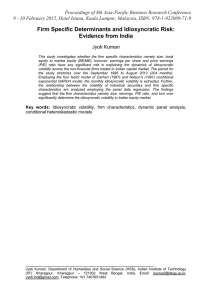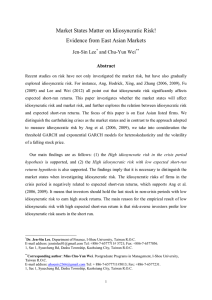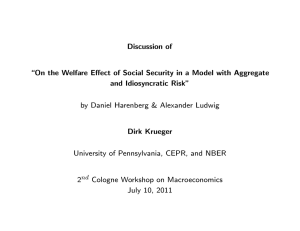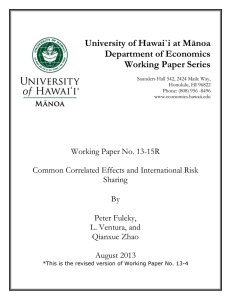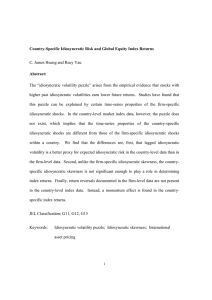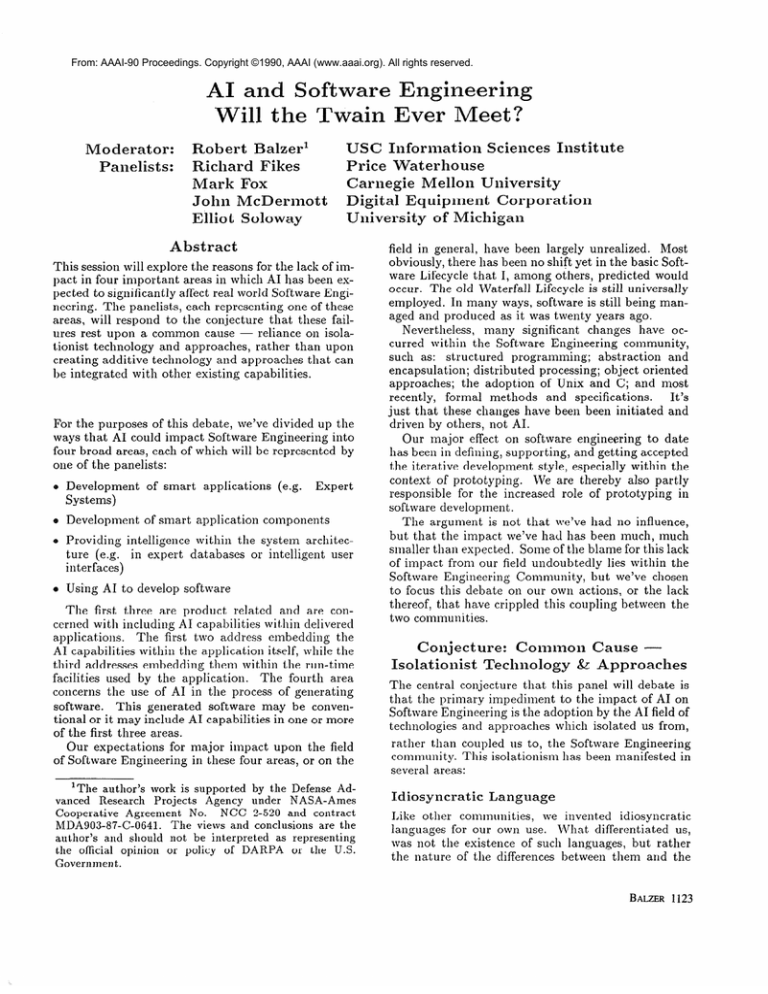
From: AAAI-90 Proceedings. Copyright ©1990, AAAI (www.aaai.org). All rights reserved.
AI and Software Engineering
Will the Twain Ever Meet?
USC Iuforination
Scieuces Iustitute
Price Waterhouse
Carnegie Mellon University
Digital Equipment
Corporation
University
of Michigan
Robert Balzerl
Richard Fikes
Mark Fox
John McDermott
Elliot Soloway
Moderator:
Panelists:
Abstract
This session will explore the reasons for the lack of impact in four important
areas in which AI has been expected to significantly
affect real world Software Engineering. The panelists, each representing
one of these
areas, will respond to the conjecture
that these failures rest upon a common cause - reliance on isolationist technology
and approaches,
rather than upon
creating additive technology and a.pproaches that can
be integrated
with other existing capabilities.
l?or the purposes of this debate, we’ve divided up the
ways that AI could impact Software Engineering
into
four broad areas, each of which will be represented by
one of the panelists:
o Development
Systems)
of smart
e Development
of sma.rt application
e Providing
ture (e.g.
interfaces)
intelligence
in expert
a.pplications
(e.g.
Expert
components
within the system architecdatabases
or intelligent
user
o Using AI to develop software
The first three are product related and are concerned with including AI capabilities
within delivered
The first two address embedding
the
applications.
AI capabilities
within the application itself, while the
third addresses embedding them within the run-time
facilities used by the application.
The fourth area
concerns the use of AI in the process of generating
software.
This generated
software may be conventional or it may include AI capabilities
in one or more
of the first three areas.
Our expectakions
for major impact upon the field
of Software Engineering
in these four areas, or on the
‘The author’s work is supported
by Bhe Defense Advanced Research
Projects
Agency
under NASA-Ames
Cooperative
Agreement
No.
NCC Z-520 and contract
MDA903-87-C-0641.
The views and conclusions are the
author’s and should not be interpreted
as representing
the olficial opinion or policy of DARPA
or the U.S.
Government.
field in genera.1, have been largely unrealized.
h/lost
obviously, there has been no shift yet in the basic Software Lifecycle that I, among others, predicted would
occur. The old Waterfall Lifecycle is still universally
employed. In many ways, software is still being managed and produced as it wa.s twenty years ago.
Nevertheless,
many significant
changes have occurred within the Software Engineering
community,
such as: structured
programnling;
abstraction
and
encapsulation;
distributed
processing; object oriented
approaches;
the adoption of Unix and C; and most
recently,
formal methods
and specifications.
It’s
just that these changes have been been initiated and
driven by others, not AI.
Our major effect on software engineering
to date
has been in defining, supporting,
and getting accepted
the iterative development style, especially within the
context of prototyping.
We a.re thereby also partly
responsible
for the increased role of prototyping
in
software development.
The argument is not that we’ve had no influence,
but that the impact we’ve had has been much, much
smaller than expected.
Some of the blame for this lack
of impact from our field undoubtedly
lies within the
Softwa.re Engineering
Communit~y, but we’ve chosen
to focus this debate on our own actions, or the lack
thereof, that have crippled this coupling between the
two communities.
Conjecture:
Common
Cause Isolationist
Technology
& Approaches
The central conjecture
that this panel will debate is
that the primary impediment
to the impact of AI on
Software Engineering is the adoption by the AI field of
technologies
a.ncl approaches which isolated us from,
rather than coupled us to, the Software Engineering
community.
This isolationism
has been manifested in
several areas:
Idiosyncratic
Language
Like ot,ller communities,
we invented
idiosyncratic
languages for our own use. \Vha.t differentiated
us,
was not the existence
of such languages,
but rather
the nature of the differences between them and the
BALZER 1123
standard
algebraic languages
in use throughout
the
rest of the community
and our interest in symbolic
rather than numeric computation.
Idiosyncratic
Environment
What really set us apa.rt was the creation of idiosyncratic environments,
programmed
in our idiosyncratic
language, and utilizing its symbolic computation
facilities to represent and manipulate
the computation
structures of the application being executed and of the
environment
itself. This ability to manipulate
those
computation
structures
gave rise to a, wealth of late
binding mechanisms
to dynamically
control and alter
their meaning.
In contrast, the rest of the community used far simpler, less powerful, (intentionally)
less flexible, and
much less encompassing
environments.
Idiosyncratic
Hardware
Having created our own language and support enviromnents, and not content to merely ride the crest of
the emerging hardware revolution, we took the opportunity afforded by this revolution
to create our own
machines.
The specialized architectures
of those machines certainly provided us with an immediate
benefit of in- .
creased power. But it also clearly launched us on a
trajectory
away from the rest of the computing community. Not only did we do our work in a.n idiosyncratic language,
but we also now did it in sepa.ra.te
machines that didn’t run anything
else.
Moreover,
this meant that the operating system itself had to be
written in Lisp. This cut any remaining
ties resulting from a shared reliance on a common operating
system as we had 1la.d 011 the previous generation
of
mainfra.mcs.
The primitive state of distributed system
support that existed at tl1a.t time virtually completed
our isolation.
We not only crea.tecl idiosyllcratic,
high performance, development
machines,
but we also created
low-cost compatible
delivery machines 011 which to
run the applications
we expected
to be built and
widely disseminated.
We all know now, with the advanta.ge of hindsight,
that this idiosyncratic
hardwa.re thrust was not sustainable - in part because the expected market did
not develop, but also because of the huge development
costs of keeping up with the rapidly improving VLSI
state-of-the-art.
Recently,
our isolation has been eased somewhat
by the improving state of network support for distributed
processing
and by the appearance
of coprocessor plug-in boards for providing our specialized
hardware support within conventional
workstations
and PCs.
It is interesting to note that no other language community chose to pursue a similar, specialized
hardware, route.
1124 INVITED TALKS AND PANELS
Separate
Infrastructure
the natural progression
of our separation
trajecOur softtory, we built our own infrastructure.
ware development and execution environments
are arguably the best ever created. But these environments
also had a dark side. The better they became, the
more we relied upon them. The more we relied up011
them, the more insular we became, and the bigger the
gap became between our support facilities and those
common and accepted within the Software Engineering community.
in the expectation
of major
We also created,
growth,
our OWI~ service industry
of software and
hardware
vendors and consultants
to support
our
small, tight-knit
community.
In
Large
Footprint
One major problem resulting from our wealth of environmental
infrastructure,
was the ease with which
it could be incorporated
in our applications,
and the
difficulty of separating
the part we depended up011
from the rest of this infrastructure.
This resulted in
very large footprints
(i.e. memory requirements)
for
a.11but the simplest applications.
Our response ha.s traditionally
been to just add
more real memory with the knowledge
that memory was always getting
chea.per.
But this hardware bail-out exacerbated
our isolation by creating
widely different hardware support requirements
between ourselves and the mainstream
computing community that relied on minimally configured workstations, or even PCs.
It is only recently, that we’ve taken this problem seriously enough to develop the necessary delivery technology to sepa.rate out just the portions of the environment really needed by an application,
and thereby
reduce the a.pplication’s footprint.
Weak
Interoperability
The a.11encompa.ssing nature of our environments,
the
isolation induced by idiosyncratic
hardware, and the
dynamicism
of our language all conspired to lessen
our interest in supporting
interoperability
with other
languages and/or machines.
We’ve certainly
created connections
betwee
Lisp
and other systems, but almost always in a.cl-hoc special purpose ways rather than building generic interThere don’t seem to be any
operability
mechanisms.
technical obstacles tha.t a.re greater tl1a.n those facing
other communities
-- just, less commitment
on our
past.
No Encapsulation
While the rest of the Software Engineering
community
has been engaged for some time in perfecting
mechanisms for structuring
applications
by dividing them
into manageable subunits with well-defined and enforcable interfaces betwee.n them, we have continued our
pursuit of flexibility.
In that pursuit, we have largely
ignored, and failed to support, the mechanisms
used
by others for early bindings and declarations
of static
structure.
We have no interface definition languages,
encapsulation
mechanisnis2,
or type-safe languages.
In the absence of such encapsulation
mechanisms,
we have no reliable means of breaking systems up into
well-defined pieces. Hence, the understandability
and
maintainability
of our systems is highly suspect, relying instead on conventions,
good coding styles, and
accurate documentation.
e What impacts should we have had, given the technologic advances we’ve made?
Egocentric
e What t8echnical problems should we have been addressing in order to have had more of an impact?
Mehtality
1 t is ii0 coincidence that our major commercial thrust
is called “Expert
Systcnls”
rather
than
“Expert
We developed a technology
for buildSubsystems.”
ing a whole generation
of stand-alone
systems created and run totally within our own technology which
solved some complete user problem.
Rather than creating subsystems
which could ea.sily fit into existing
systems, we temporarily
avoided the issue by focusing
on
problems which allowed stand-alone
solutions.
Another real user need we’ve ignored, beyond creating new expert subsystems
and components,
and
potentially
even more important,
is making existing
components
smarter - that is, developing the technologic and methodologic
base for incrementally
integrating knowledge or rule-based
capabilities
into the
existing structure of some component.
Marketplace
Reaction
Isolation
Questions
to be Debated
e Do you agree that we’ve had little impact on Software Engineering ? If not, what major impacts do
you think we’ve had?
e Do you agree that the main cause of this lack
of impact is our isolationist
technologies
and approaches? If not, what are the main causes?
e Finally, what technical problems should we now be
addressing,
and what impacts do you foresee from
working on those problems?
to AI’s
It is also no coincidence
that the marketplace
has
rejected
our isolationist
and egocentric
approach.
They’ve
demanded
that both the generated
expert
system applications
and the shells that produce them
run on Unix Workstations
a.nd PC!s, be coded in C (to
improve performance
and simplify interoperability),
and be interfa.ced to the rest of the client’s system
and the environment
in which the generated
component will operate.
Likewise, the sponsors of the various software engineering consortia., institutes,
and industrial
research
laboratories
have rejected technology
transfer utilizing Lisp ba.sed systems because they don’t integrate
or interoperate
well, and because they don’t have Lisp
knowledgeable
people to maintain
and evolve these
systems.
The
commercial
marketplace
is moving
quite
rapidly toward adoption of a set of architectural
and
interoperability
standards
that support componentwise heterogeneity,
and unless we can open up and
unbundle our monolithic Lisp environments,
we’ll find
ourselves even more isolated and rejected.
2 Common Lisp’s packages provide only the most primit,ive mechanisms for sepa.rat.ing the public and private
parts of an application, but no means of enforcing tl1a.t
separation
BALZER
1125

